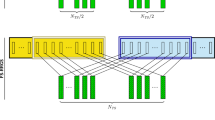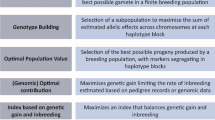Abstract
Reciprocal recurrent selection (RRS) has been successfully applied to maize breeding for more than 60 years. Our objective was to assess the relative efficiency of the genotypic value and the effects of general and specific combining abilities (GCA and SCA) on selection. The GCA effect reflects the number of favorable genes in the parent. The SCA effect primarily reflects the differences in the gene frequencies between the parents. We simulated three traits, three classes of populations, and 10 cycles of half- and full-sib RRS. The RRS is a highly efficient process for intra- and interpopulation breeding, regardless of the trait or the level of divergence among the populations. The RRS increases the heterosis of the interpopulation cross when there is dominance, and it decreases the inbreeding depression in the populations and the genetic variability in the populations and in the hybrid. When there is not dominance and the populations are not divergent, the RRS also determines population differentiation. The half-sib RRS, which is equivalent to selection based on the GCA effect, is more efficient than the full-sib RRS based on the genotypic value, regardless of the trait or the level of improvement of the populations. The full-sib RRS based on the SCA effect is not efficient for intra- and interpopulation breeding.
Similar content being viewed by others
References
Butruille DV, Silva HD, Kaeppler SM, Coors JG (2004) Response to selection and genetic drift in three populations derived from the Golden Glow maize population. Crop Sci 44:1527–1534
Comstock RE, Robinson HF, Harvey PH (1949) A breeding procedure designed to make maximum use of both general and specific combining ability. Agron J 41:360–367
Eberhart SA, Debela S, Hallauer AR (1973) Reciprocal recurrent selection in the BSSS and BSCB1 maize populations and half-sib selection in BSSS. Crop Sci 13:451–456
Hallauer AR (1967) Development of single–cross hybrids from two-eared maize populations. Crop Sci 7:192–195
Hallauer AR, Eberhart SA (1970) Reciprocal full-sib selection. Crop Sci 10:315–316
Hallauer AR, Carena MJ, Miranda Filho JB (2010) Quantitative genetics in maize breeding. Iowa State University Press, Ames
Hinze LL, Kresovich S, Nason JD, Lamkey KR (2005) Population genetic diversity in a maize reciprocal recurrent selection program. Crop Sci 45:2435–2442
Jenweerawat S, Aekatasanawan C, Laosuwan P, Hallauer AR (2009) Interpopulation hybrid development in maize using modified reciprocal recurrent selection. Thai J Agric Sci 42:139–148
Jones LP, Compton WA, Gardner CO (1971) Comparison of full and half-sib reciprocal recurrent selection. Theor Appl Genet 41:36–39
Keeratinijakal V, Lamkey KR (1993) Responses to reciprocal recurrent selection in BSSS and BSCB1 maize populations. Crop Sci 33:73–77
Labate JA, Lamkey KR, Lee M, Woodman WL (1997) Molecular genetic diversity after reciprocal recurrent selection in BSSS and BSCB1 maize populations. Crop Sci 37:416–423
Lonnquist JH, Williams NE (1967) Development of maize hybrids through selection among full-sib families. Crop Sci 7:369–370
Ordas B, Butron A, Alvarez A, Revilla P, Malvar RA (2012) Comparison of two methods of reciprocal recurrent selection in maize (Zea mays L). Theor Appl Genet 124:1183–1191
Peakall R, Smouse PE (2006) GENALEX 6:genetic analysis in Excel Population genetic software for teaching and research. Mol Ecol Notes 6:288–295
Peiris BL, Hallauer AR (2005) Comparison of half-sib and full-sib reciprocal recurrent selection and their modifications in simulated populations. Maydica 50:25–37
Penny LH, Eberhart SA (1971) Twenty years of reciprocal recurrent selection with two synthetic varieties of maize (Zea mays L). Crop Sci 11:900–903
Rademacher MAM, Hallauer AR, Russell WA (1999) Comparative response of two reciprocal recurrent selection methods in BS21 and BS22 maize populations. Crop Sci 39:89–97
Rodriguez OA, Hallauer AR (1991) Variation among full-sib families of corn for different generations of inbreeding. Crop Sci 31:43–47
Romay MC, Ordas B, Revilla P, Ordas A (2011) Three cycles of full sib reciprocal recurrent selection in two Spanish maize populations. Crop Sci 51:1016–1022
Russell WA, Eberhart SA (1975) Hybrid performance of selected maize lines from reciprocal recurrent and testcross selection programs. Crop Sci 15:1–4
Santos MF, Câmara TMM, Moro GV, Costa EFN, Souza CL Jr (2007) Responses to selection and changes in combining ability after three cycles of a modified reciprocal recurrent selection in maize. Euphytica 157:185–194
REAL Software (2004) REALbasic 5.5. Version 5.5.4. REAL Software Inc, Austin TX
Solomon KF, Martin I, Zeppa A (2010) Temporal genetic structure patterns in tropical maize populations under reciprocal recurrent selection. Euphytica 176:239–249
Souza CL Jr (1987) Reciprocal recurrent selection with half-sib progenies obtained alternately from noninbred (S0) and inbred (S1) plants in maize. Maydica 32:19–31
Souza CL Jr, Barrios SCL, Moro GV (2010) Performance of maize single-crosses developed from populations improved by modified reciprocal recurrent selection. Sci Agric 67:198–205
Viana JMS, Faria VR, Silva FF, Resende MDV (2011) Best linear unbiased prediction and family selection in crop species. Crop Sci 51:2371–2381
Acknowledgments
We thank the Foundation for Research Support of Minas Gerais State (Fapemig), the Brazilian Federal Agency for Support and Evaluation of Graduate Education (Capes), and the National Council for Scientific and Technological Development (CNPq) for financial support.
Author information
Authors and Affiliations
Corresponding author
Additional information
Communicated by M. Sillanpaa.
Rights and permissions
About this article
Cite this article
Viana, J.M.S., DeLima, R.O., Mundim, G.B. et al. Relative efficiency of the genotypic value and combining ability effects on reciprocal recurrent selection. Theor Appl Genet 126, 889–899 (2013). https://doi.org/10.1007/s00122-012-2023-3
Received:
Accepted:
Published:
Issue Date:
DOI: https://doi.org/10.1007/s00122-012-2023-3




